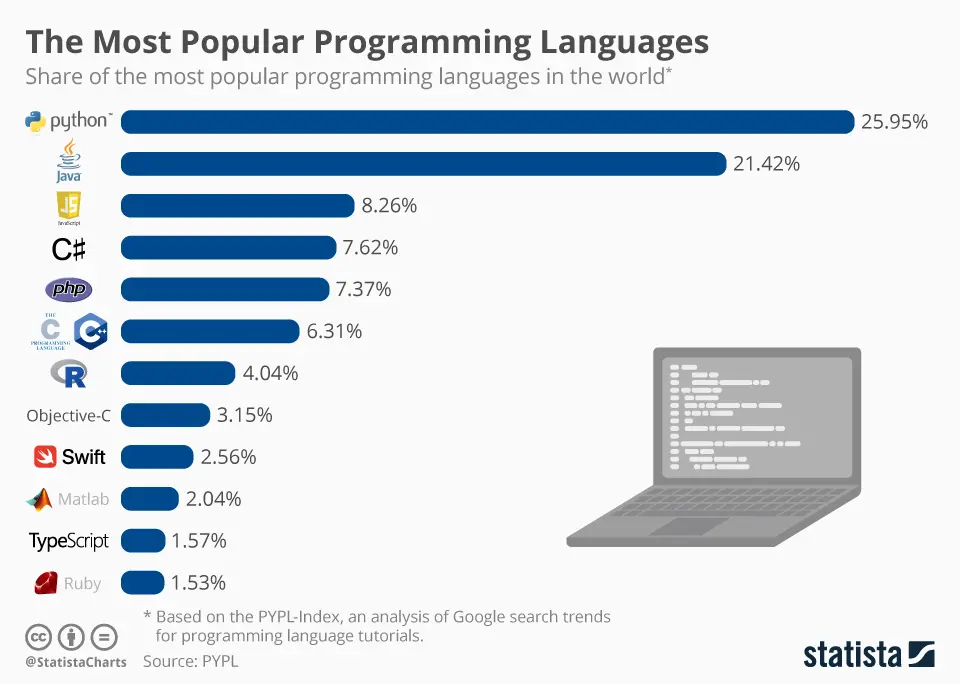
Moonpreneur
Update: This article was last updated on 23 November 2023 to reflect the accuracy and up-to-date information on the page.

Image Source: Pinterest
People have many questions about coding, such as why it is important to learn it, how we learn it, where we should learn it, the long-term benefits, and so on. In this article, we answer a list of frequently asked coding questions.

The answers will be useful for children aged 8 to 14 years and will serve as a comprehensive resource for aspiring programmers, covering everything from fundamental concepts such as HTML and CSS to more complex subjects such as recursion and encryption.
Knowing how to code has become a necessary skill in today’s technologically advanced world, and it’s never too early to start. So, let’s get started and explore the world of coding together.
1. What is coding?
We communicate with computers through coding. It is the process of developing instructions for a computer to understand and execute. Coding is the process of creating software, applications, websites, and other technological tools with the help of one or more programming languages, such as Java, Python, and C++.
These commands specify what to do to the machine and how to do it. To put it another way, coding is the process of writing instructions in a language that a machine can understand and execute.
2. What is HTML?
The full form of HTML is HyperText Markup Language. It is a markup language used to make web applications and pages. It defines the structure and content of a webpage through a series of tags and attributes interpreted by web browsers.
For instance, when you visit a website, your browser receives the HTML code and interprets it to show the web page because web browsers use HTML to render web pages. HTML is the foundation of the internet, making it a crucial skill for web designers.
3. What is CSS?
CSS (Cascading Style Sheets) is a language used for creating style and layout web pages by defining the appearance and positioning of HTML elements. The style sheets describe how a document written in a markup language, such as HTML or XML, should be presented.
It enables web designers to isolate a web page’s presentation from its content, making it simpler to alter and manage its layout and design. CSS defines styles for HTML elements such as font size, color, spacing, borders, and background images.
4. What is JavaScript?
JavaScript is a high-level, interpreted programming language that is widely used for developing web applications and creating interactive user interfaces. It frequently works with HTML and CSS to create dynamic, responsive web pages.
Without the need to refresh the page, it enables developers to construct complicated functionality like animations, form validation, and dynamic content updates.
5. What is a variable in programming?
A variable is a named storage location in programming that holds a value or data. Programmers use variables to store and manipulate data and to give their code a mechanism to remember and use values over time. Before being utilized in a program, variables are normally declared and initialized with a value.
Throughout the program, references to a variable’s value are made using the variable’s name. While the program is running, it can be given a value and changed.
6. What is a loop in programming?
A loop is a programming construct that allows instructions to be repeatedly executed if a certain condition is true. In other words, a loop enables you to run a block of code repeatedly without having to repeatedly write the same code.
Programmers frequently use loops to handle massive amounts of data, iterate over lists or arrays, and look for specific elements. They can lessen the risk of errors while making code more efficient and concise.
7. What is an array in programming?
An array is a group of identically typed elements that are kept in consecutive memory regions and can be accessed using an index or a subscript. The basic data structure used in programming that enables us to store and manage collections of data is called an array.
A fixed size is typically given for an array, indicating the maximum number of elements it can hold.
8. What is a function in programming?
A function in programming is a section of code that completes a particular task and may be accessed from other areas of a program. Code organization, modularization, reusability, and avoiding creating duplicate code are all achieved through the use of functions.
Functions take input arguments and can either perform a sequence of actions without returning a value, or they can return output values.
9. What is debugging in programming?
Debugging is finding and removing faults or errors from software. Bugs in programming are errors in the code that lead to unexpected behavior or inaccurate outcomes.
Debugging is a crucial step in software development since it guarantees that programs are working properly and providing the desired results. Even though sophisticated systems can make debugging time-consuming, it is a crucial ability for all programmers.
10. What is a conditional statement in programming?
A conditional statement in programming is a control structure that allows the program to make decisions and execute different code paths based on whether a certain condition is true or false. It typically uses keywords such as “if,” “else if,” and “else” to evaluate a condition and perform the corresponding actions.
The ability to influence the flow of a program based on various conditions makes conditional statements an essential programming construct. Input validation, error management, and algorithm creation are just a few of the many activities they employ.
11. What is object-oriented programming?
A programming paradigm known as object-oriented programming (OOP) focuses on using objects, which are instances of classes, to represent and manipulate data and behavior. It is based on the notion that objects can contain data (attributes or properties) and code (methods or functions) to manipulate that data.
You can divide your code into reusable, expandable components that are easier to maintain over time with OOP. In object-oriented programming (OOP), objects are instances of classes that serve as models or blueprints for building objects.
12. What is recursion in programming?
Recursion is a technique in programming where a function calls itself repeatedly until a predetermined condition is satisfied. Recursion can be used for solving problems that can be broken down into smaller, similar subproblems that are related to the main issue.
Combining the answers to the smaller sub-problems yields the answer to the main issue. Recursion can be an effective and elegant method for tackling some problems, but it can also be complicated and challenging to comprehend and debug.
13. What is version control?
Version control enables you to keep track of changes made to your code over time. Several persons can work on the same files simultaneously without overwriting each other’s modifications since it offers a mechanism to track and record the history of changes to a file or set of files. Each collection of modifications to a file or set of files in version control is called a “commit.”
Each commit includes a special identity, a timestamp, and a message outlining the modifications performed.
14. What is a database?
An organized group of data that is simple to maintain, retrieve, and update is known as a database. It is a software program that enables organized data storage, retrieval, and manipulation.
Databases are utilized in a wide range of applications, including desktop software, mobile apps, and web applications. One or more tables, which are arranged into columns (fields) and rows, make up a database (records).
15. What is a web application?
Any software program that runs in a web browser or other web-based client and connects with a web server via the Internet is called a web application. It is often made to offer a user interface so that people may interact with the data or services the web server provides.
Web apps can be as simple as informational static websites or as complicated as dynamic websites with interactive elements and real-time data changes.
16. What is an algorithm?
A set of instructions or rules used to solve a problem or carry out a task is known as an algorithm. It is a specified set of steps that can be taken to carry out a particular task or get the desired result. A wide range of disciplines, including computer science, mathematics, engineering, and more, use algorithms.
For dealing with issues like sorting through vast amounts of data, looking for a specific piece of information, or processing digital photographs and video, algorithms are frequently used since they are either too difficult or time-consuming to be dealt with manually.
17. What is encryption?
The process of transforming plain text or data into a coded form that is unintelligible to outsiders is known as encryption. Encryption safeguards information’s integrity and confidentiality by making it difficult for unauthorized parties to view, read, or alter it.
Data is encrypted using an algorithm and a secret key to create a format that is challenging to decode without the key.
18. What is a data structure?
An effective technique of organizing and storing data in a computer program or application is called a data structure. It is a group of data values, their connections, and the operations or functions that can be applied to the data. It’s critical to select the appropriate data structure to optimize both program performance and memory use.
19. What is a compiler?
A compiler is a piece of software that converts source code written in a programming language into executable machine code. The compiler examines the source code, looks for problems and creates an executable file that can be used with a certain hardware configuration and operating system.
Many distinct programming languages, including C, C++, Java, and Python, among others, employ compilers.
20. What is a software library?
A software library often referred to as a library or a code library, is a collection of pre-written code, modules, and routines that can be used by software developers to simplify the process of writing code for a particular programming language or platform. Libraries may contain code for activities including input/output, networking, data storage, user interface design, algorithms, and data structures, and they may be made for particular programming languages or systems.
Popular software libraries include, among many others, the Python Standard Library, the.NET Framework Class Library, and the Java Standard Library.
Conclusion
Basic knowledge can sometimes turn into a treasure trove. These 20 questions and answers will aid in developing a knowledge base for you to use while learning to code. In fact, by studying these concepts and practicing with practical coding activities, you can lay a solid foundation in programming.
This only scratches the surface. Thanks to the resources and assistance made available through online courses, coding camps, and mentorship programs, you have many opportunities to explore the world of coding and learn about the exciting possibilities that await you.
Moonpreneur understands the needs and demands this rapidly changing technological world is bringing with it for our kids, offering coding classes for kids to empower them with essential skills.
Thus we are on a mission to educate and ignite the flames of entrepreneurship through our holistically created online STEM programs, which will help kids master the futuristic sciences such as Robotics, Game Development, App Development, Advanced Math, and much more!!
Register for a free 60-minute Robotics & Coding class today!
















